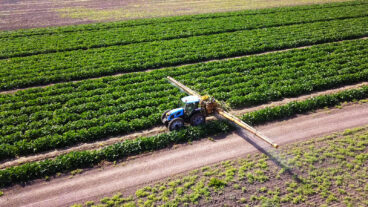While most people worry about climate change as a future event; its negative impact is already being felt on the planet’s water cycles today, according to Prof. Daniel Rosenfeld, a scientist at the Hebrew University in Jerusalem.
In a study carried out with Chinese researchers, Rosenfeld discovered that airborne particulate pollution from China’s factories and vehicles is seriously reducing rainfall in hilly areas of the country, a phenomenon that will have dire consequences for water resources.
The study, which is relevant to all other hilly semi-arid regions of the world including California and the Middle East, shows that the average precipitation of Mount Hua, near Xian in central China has decreased by 20 percent over the last 50 years, as levels of manmade air pollution have risen. On days with the poorest visibility due to pollution particles in the air (when visibility was less than 8km at the mountain top), the study found that the level of rainfall in the hills fell by 30-50 percent.
“There is a direct inverse relationship between the amount of pollution particles in the air and the fall in rainfall,” Rosenfeld told ISRAEL21c. “Everyone is worried about future changes to the climate, but we are already inflicting it upon ourselves now. We should be aware of this and do something to stop it immediately.”
Rosenfeld, who has won many awards for his work, including the Schaefer and Thunderbird awards from the Weather Modification Association and the Verner Suomi Medal of the American Meteorological Society, has been studying this field for many years. In 2000 he used satellite data to show that urban pollution was reducing the size of water droplets inside clouds and proposed that this would reduce precipitation from short-lived clouds in hilly regions. His work sparked interest in China, which like so much of Asia is seeing rapid industrialization and a growth in dangerous smogs, and he was invited to visit the country, and put his theories to the test.
The authors of Rosenfeld’s latest report included Zhanyu Yao of the Chinese Academy of Meteorological Science, and Jin Dai from the Meteorological Institute of Shaanxi Province, China. The team compiled their report using more than 50 years worth of records showing precipitation and visibility at the top of Mount Hua, one of five sacred mountains in China, 2,060m above sea level. Data on lowland rainfall came from two weather stations on the plains nearby, at Xian and Huayin.
The researchers linked the decreasing visibility at Mount Hua’s summit (38 kilometers in 1954, compared to about 20km in 2006) with increasing air pollution particles, from smoke, aerosols, power plants, burning vegetation, and vehicle exhausts. They showed that the higher the concentration of these fine, airborne pollutants (aerosols) in the air, the less precipitation there is. The rain falls later, and it falls on the plains where it is less effective.
“It is very important for rain to fall in the right quantities and in the right place,” explains Rosenfeld. “Most of our water resources come from mountainous areas and communities in semi-arid regions, even sometimes hundreds of kilometers away, rely on this water. If the rain stops falling in the hills and falls instead across the plain, it might be nice for the camels, but it won’t help our water supplies.”
Rainfall over the mountains occurs when moist air is forced up against one side of the mountain, cools, and is then forced down on the other side, causing the water vapor to condense. These clouds have a short lifetime. Pollution upsets this delicate balance. Water vapor condenses on the pollution particles, creating a cloud with a large number of drops that are so small they float in the air. Before these tiny drops have a chance to grow large enough to fall as raindrops or snow, the lifetime of the cloud is already over. Instead, the water evaporates into the air.
“These clouds don’t have enough time to convert their water into large enough water drops that would fall as snowflakes or raindrops,” says Rosenfeld.
Aerosol particles should not affect rain in lowland areas as the mechanism is different. Moist air is pushed upwards by upwinds, and the water still has time to coalesce into proper raindrops or snowflakes.
According to Rosenfeld, the Chinese study, which was published in the March issue of the journal Science, is a template for other hilly areas of the world that suffer the same type of pollution – in particular, California, where Rosenfeld has also carried out research and which has similar physical conditions, climate and topography to the Chinese research area. According to a report funded by the California Energy Commission’s Public Interest Energy Research (PIER) program and the Department of Water Resources, California’s precipitation losses over the Sierra Nevada mountain range are projected at 10-25%.
“In the densely populated area of southern California rainfall is reducing, while in northern California, where the countryside is still pristine and sparsely populated, precipitation remains at its usual level,” says Rosenfeld, who worked for some years as a research associate at the Severe Storms Branch of the Goddard Space Flight Center at NASA in the 1980s.
Similar trends were also identified in the western US, Israel, South Africa, Portugal, France, Switzerland, Morocco, Canada, Greece and Spain. “Wherever you find mountains combined with large urbanization you see this trend,” explains Rosenfeld. This spells trouble for semi-arid countries where water is already in short supply. “It is not heat or cold that turns an area into an uninhabitable desert, it is the presence of water,” adds Rosenfeld.
In China, for example, mountains rains are a major source of water for many rivers, including the Yellow River, which is used by local people to irrigate their fields. Israel has also experienced problems with precipitation decreases that have affected the flow of the Jordan River.
In the past, studies have suggested that pollution particles in clouds could offset global warming by altering their composition so that they reflect more solar radiation back into space, cooling temperatures on earth. Rosenfeld’s study, however, indicates that climate change is far more complicated than this, and that a benefit in one area, can lead to a significant problem in another.
“Global warming has become a very major issue and there are many uncertainties in this field, but the biggest uncertainty lies in the impact of pollution particles in the atmosphere, and how these will affect the climate,” says Rosenfeld. “A 10-25 percent decrease in rainfall is dramatic, particularly if the shortfall occurs where it matters most.
“In recent years there has been a decrease in the number of mass particulates in the air, but there has been no decrease in the number of small particulates that affect clouds. We have to take note of what is happening to our water resources,” adds Rosenfeld. “People must do something about it. The world has to cut down on air pollution.”













